作者:京东零售 冯晓涛
问题背景
京东生旅平台慧销系统,作为平台系统对接了多条业务线,主要进行各个业务线广告,召回等活动相关内容与能力管理。
最近根据告警发现内存持续升高,每隔 2-3 天会收到内存超过阈值告警,猜测可能存在内存泄漏的情况,然后进行排查。根据 24 小时时间段内存监控可以发现,容器的内存在持续上升:
问题排查
初步估计内存泄漏,查看 24 小时时间段 jvm 内存监控,排查 jvm 内存回收情况:
YoungGC 和 FullGC 情况:
通过 jvm 内存分析和 YoungGC 与 FullGC 执行情况,可以判断可能原因如下:
1、 存在 YoungGC 但是没有出现 FullGC,可能是对象进入老年代但是没有到达 FullGC 阈值,所以没有触发 FullGC,对象一直存在老年代无法回收
2、 存在内存泄漏,虽然执行了 YoungGC,但是这部分内存无法被回收
通过线程数监控,观察当前线程情况,发现当前线程数 7427 个,并且还在不断上升,基本判断存在内存泄漏,并且和线程池的不当使用有关:
通过 JStack,获取线程堆栈文件并进行分析,排查为什么会有这么多线程:
发现通过线程池创建的线程数达 7000+:
代码分析
分析代码中 ThreadPoolExecutor 的使用场景,发现在一个 worker 公共类中定义了一个线程池,worker 执行时会使用线程池进行异步执行。
public class BackgroundWorker { private static ThreadPoolExecutor threadPoolExecutor; static { init(15); } public static void init() { init(15); } public static void init(int poolSize) { threadPoolExecutor = new ThreadPoolExecutor(3, poolSize, 1000, TimeUnit.MINUTES, new LinkedBlockingDeque<>(1000), new ThreadPoolExecutor.CallerRunsPolicy()); } public static void shutdown() { if (threadPoolExecutor != null && !threadPoolExecutor.isShutdown()) { threadPoolExecutor.shutdownNow(); } } public static void submit(final Runnable task) { if (task == null) { return; } threadPoolExecutor.execute(() -> { try { task.run(); } catch (Exception e) { e.printStackTrace(); } }); } }
复制代码
广告缓存刷新 worker 使用线程池的代码:
public class AdActivitySyncJob {
@Scheduled(cron = "0 0/5 * * * ?") public void execute() { log.info("AdActivitySyncJob start"); List<DicDTO> locationList = locationService.selectLocation(); if (CollectionUtils.isEmpty(locationList)) { return; }
//中间省略部分无关代码
BackgroundWorker.init(40); locationCodes.forEach(locationCode -> { showChannelMap.forEach((key,value)->{ BackgroundWorker.submit(new Runnable() { @Override public void run() { log.info("AdActivitySyncJob,locationCode:{},showChannel:{}",locationCode,value); Result<AdActivityDTO> result = notLoginAdActivityOuterService.getAdActivityByLocationInner(locationCode, ImmutableMap.of("showChannel", value)); LocalCache.AD_ACTIVITY_CACHE.put(locationCode.concat("_").concat(value), result); } }); }); }); log.info("AdActivitySyncJob end"); }
@PostConstruct public void init() { execute(); }}
复制代码
原因分析:猜测是 worker 每次执行,都会执行 init 方法,创建新的线程池,但是局部创建的线程池并没有被关闭,导致内存中的线程池越来越多,ThreadPoolExecutor 在使用完成后,如果不手动关闭,无法被 GC 回收。
分析验证
验证局部线程池 ThreadPoolExecutor 创建后,如果不手动关闭,是否会被 GC 回收:
public class Test { private static ThreadPoolExecutor threadPoolExecutor;
public static void main(String[] args) { for (int i=1;i<100;i++){ //每次均初始化线程池 threadPoolExecutor = new ThreadPoolExecutor(3, 15, 1000, TimeUnit.MINUTES, new LinkedBlockingDeque<>(1000), new ThreadPoolExecutor.CallerRunsPolicy());
//使用线程池执行任务 for(int j=0;j<10;j++){ submit(new Runnable() { @Override public void run() { } }); }
} //获取当前所有线程 ThreadGroup group = Thread.currentThread().getThreadGroup(); ThreadGroup topGroup = group; // 遍历线程组树,获取根线程组 while (group != null) { topGroup = group; group = group.getParent(); } int slackSize = topGroup.activeCount() * 2; Thread[] slackThreads = new Thread[slackSize]; // 获取根线程组下的所有线程,返回的actualSize便是最终的线程数 int actualSize = topGroup.enumerate(slackThreads); Thread[] atualThreads = new Thread[actualSize]; System.arraycopy(slackThreads, 0, atualThreads, 0, actualSize); System.out.println("Threads size is " + atualThreads.length); for (Thread thread : atualThreads) { System.out.println("Thread name : " + thread.getName()); } }
public static void submit(final Runnable task) { if (task == null) { return; } threadPoolExecutor.execute(() -> { try { task.run(); } catch (Exception e) { e.printStackTrace(); } }); }}
复制代码
输出:
Threads size is 302
Thread name : Reference Handler
Thread name : Finalizer
Thread name : Signal Dispatcher
Thread name : main
Thread name : Monitor Ctrl-Break
Thread name : pool-1-thread-1
Thread name : pool-1-thread-2
Thread name : pool-1-thread-3
Thread name : pool-2-thread-1
Thread name : pool-2-thread-2
Thread name : pool-2-thread-3
Thread name : pool-3-thread-1
Thread name : pool-3-thread-2
Thread name : pool-3-thread-3
Thread name : pool-4-thread-1
Thread name : pool-4-thread-2
Thread name : pool-4-thread-3
Thread name : pool-5-thread-1
Thread name : pool-5-thread-2
Thread name : pool-5-thread-3
Thread name : pool-6-thread-1
Thread name : pool-6-thread-2
Thread name : pool-6-thread-3
…………
执行结果分析,线程数量 302 个,局部线程池创建的核心线程没有被回收。
修改初始化线程池部分:
//初始化一次线程池threadPoolExecutor = new ThreadPoolExecutor(3, 15, 1000, TimeUnit.MINUTES, new LinkedBlockingDeque<>(1000), new ThreadPoolExecutor.CallerRunsPolicy());
for (int i=1;i<100;i++){ //使用线程池执行任务 for(int j=0;j<10;j++){ submit(new Runnable() { @Override public void run() { } }); }
}
复制代码
输出:
Threads size is 8
Thread name : Reference Handler
Thread name : Finalizer
Thread name : Signal Dispatcher
Thread name : main
Thread name : Monitor Ctrl-Break
Thread name : pool-1-thread-1
Thread name : pool-1-thread-2
Thread name : pool-1-thread-3
解决方案
1、只初始化一次,每次执行 worker 复用线程池
2、每次执行完成后,关闭线程池
BackgroundWorker 的定位是后台执行 worker 均进行线程池的复用,所以采用方案 1,每次在 static 静态代码块中初始化,使用时无需重新初始化。
解决后监控:
jvm 内存监控,内存不再持续上升:
线程池恢复正常且平稳:
Jstack 文件,观察线程池数量恢复正常:
Dump 文件分析线程池对象数量:
拓展
1、 如何关闭线程池
线程池提供了两个关闭方法,shutdownNow 和 shutdown 方法。
shutdownNow 方法的解释是:线程池拒接收新提交的任务,同时立马关闭线程池,线程池里的任务不再执行。
shutdown 方法的解释是:线程池拒接收新提交的任务,同时等待线程池里的任务执行完毕后关闭线程池。
2、 为什么 threadPoolExecutor 不会被 GC 回收
threadPoolExecutor = new ThreadPoolExecutor(3, 15, 1000, TimeUnit.MINUTES, new LinkedBlockingDeque<>(1000), new ThreadPoolExecutor.CallerRunsPolicy());
复制代码
局部使用后未手动关闭的线程池对象,会被 GC 回收吗?获取线上 jump 文件进行分析:
发现线程池对象没有被回收,为什么不会被回收?查看 ThreadPoolExecutor.execute()方法:
如果当前线程数小于核心线程数,就会进入 addWorker 方法创建线程:
分析 runWorker 方法,如果存在任务则执行,否则调用 getTask()获取任务:
发现 workQueue.take()会一直阻塞,等待队列中的任务,因为 Thread 线程一直没有结束, 存在引用关系:ThreadPoolExecutor->Worker->Thread,因为存在 GC ROOT 的引用,所以无法被回收 。


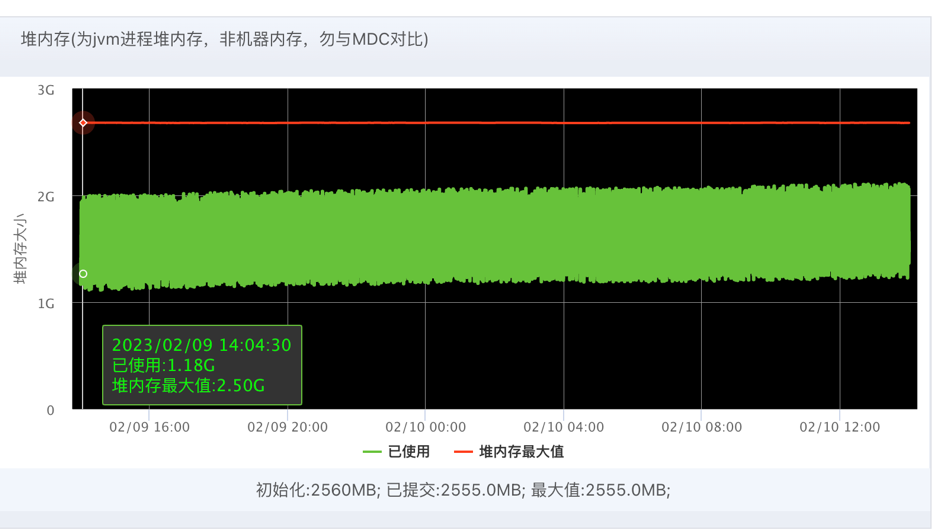

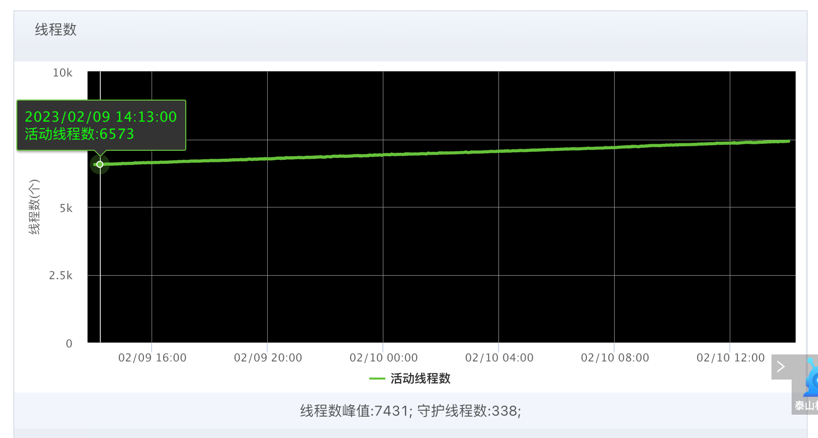

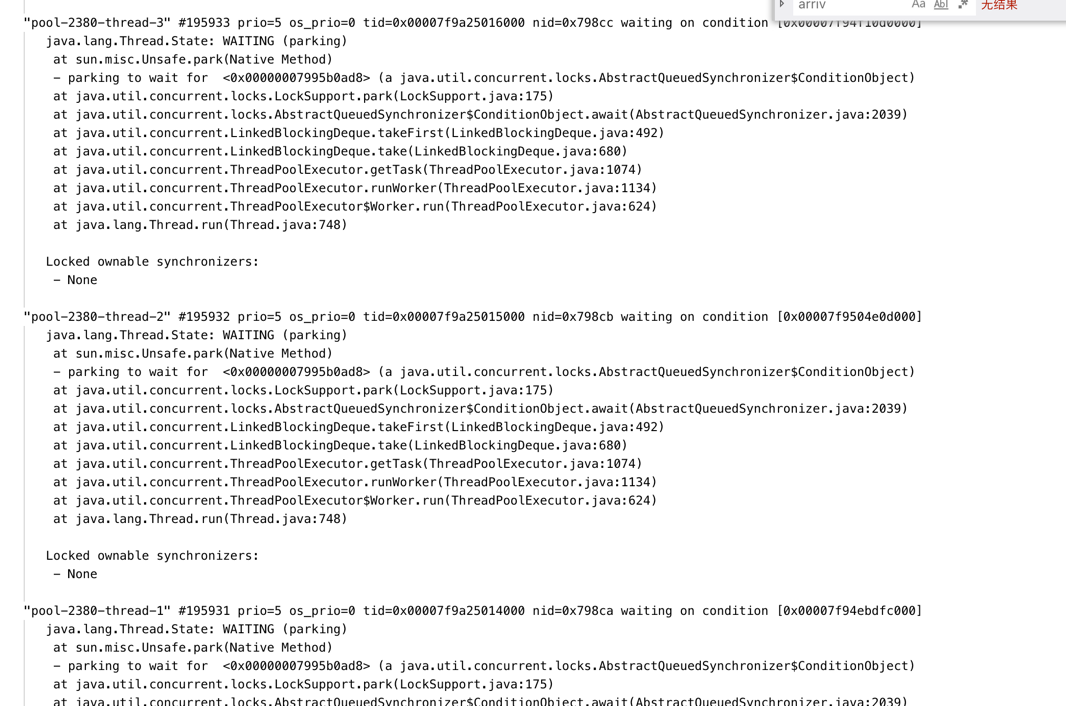

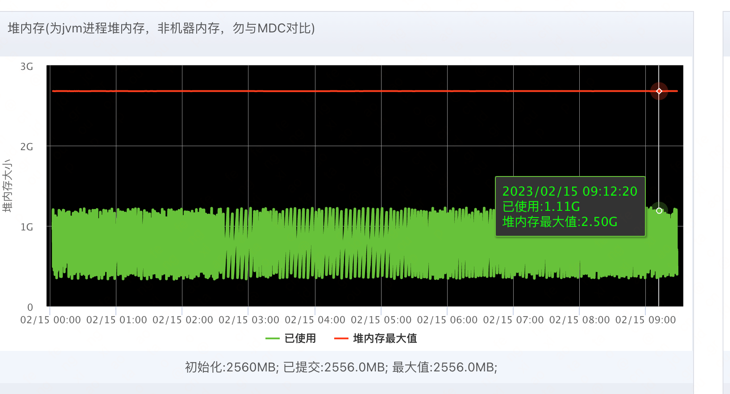
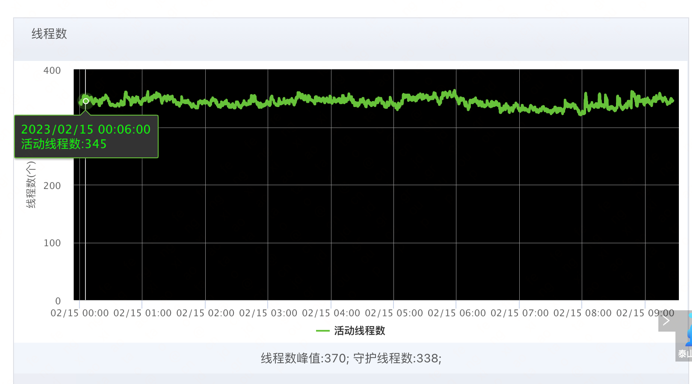
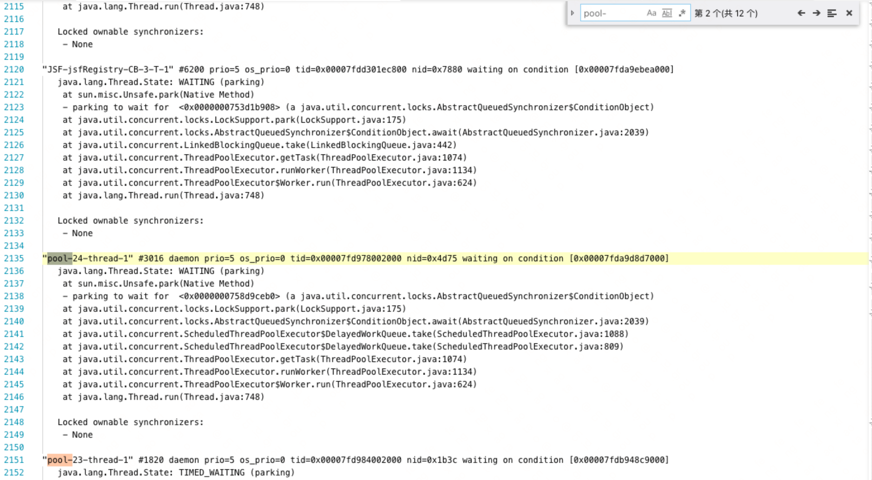
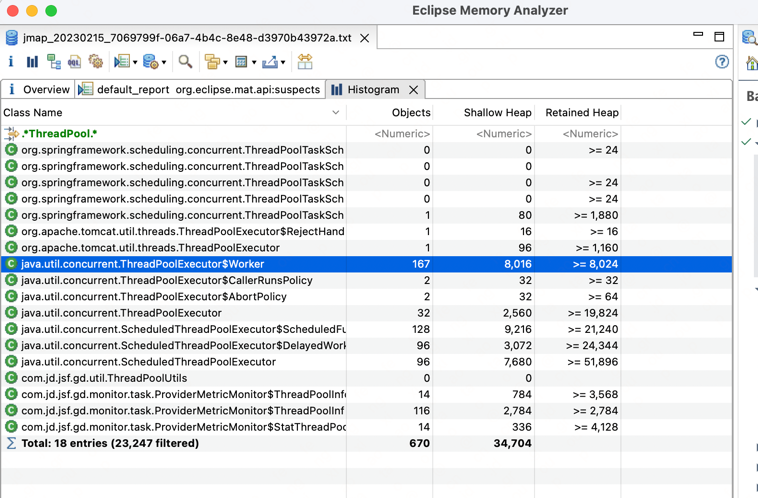
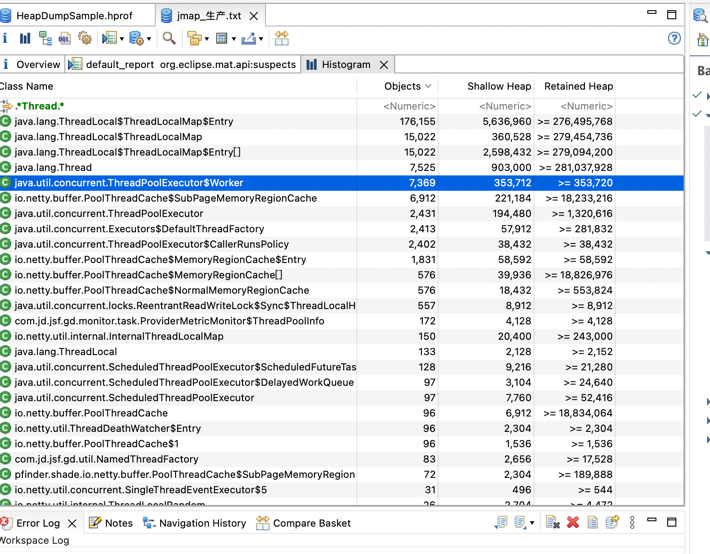
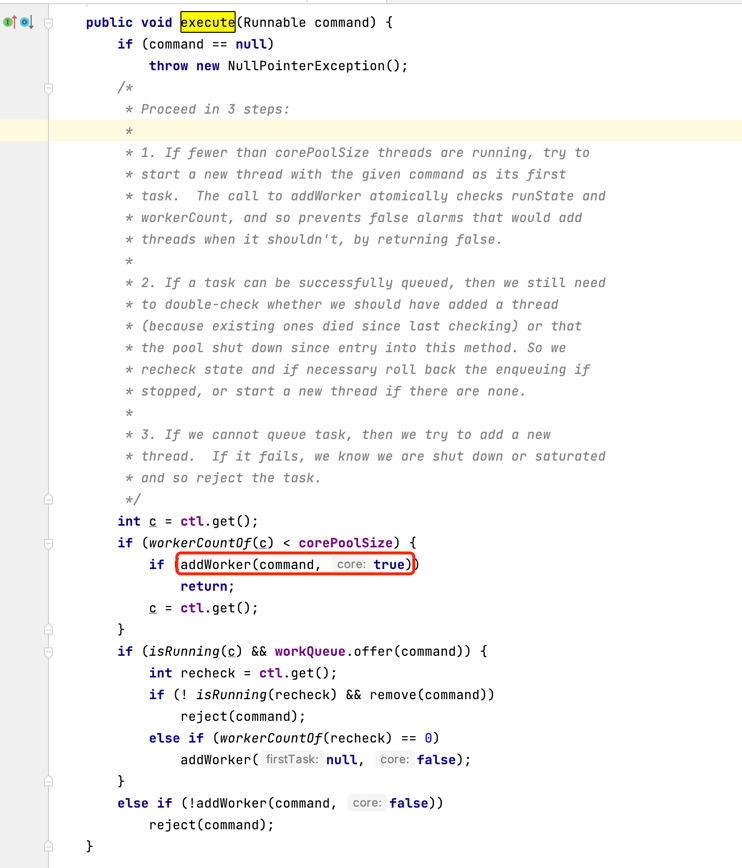
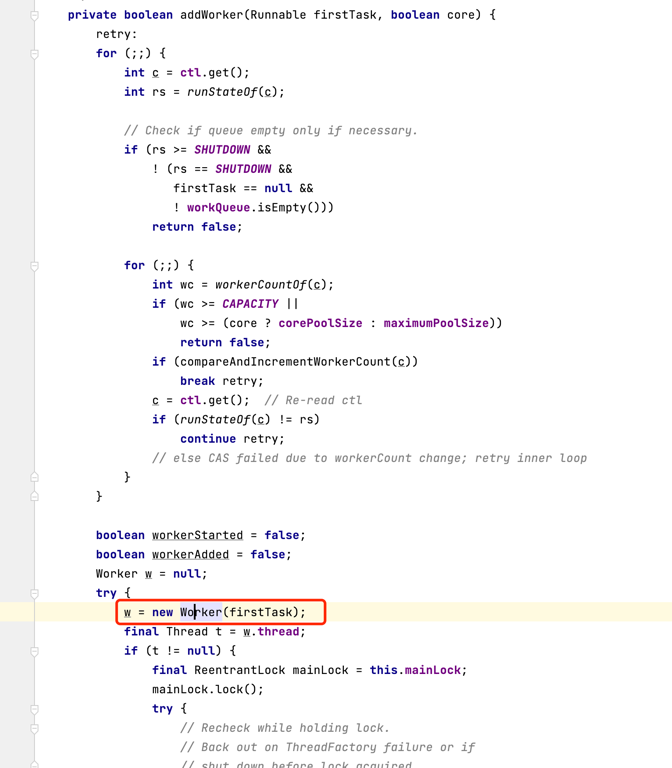
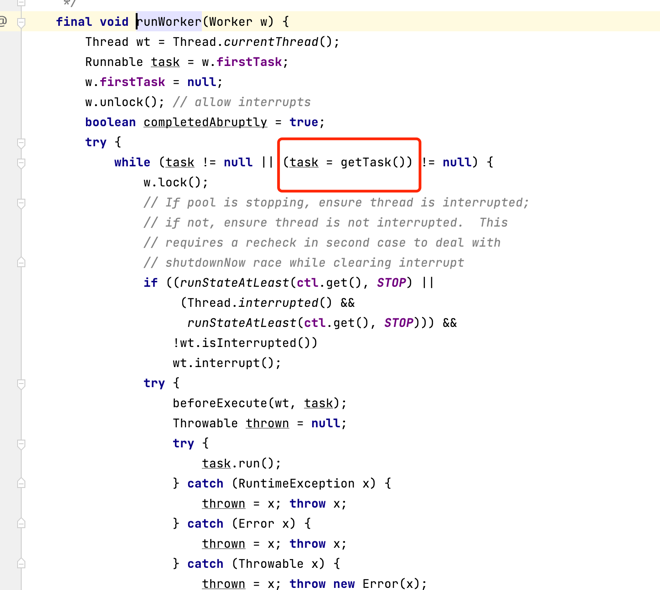
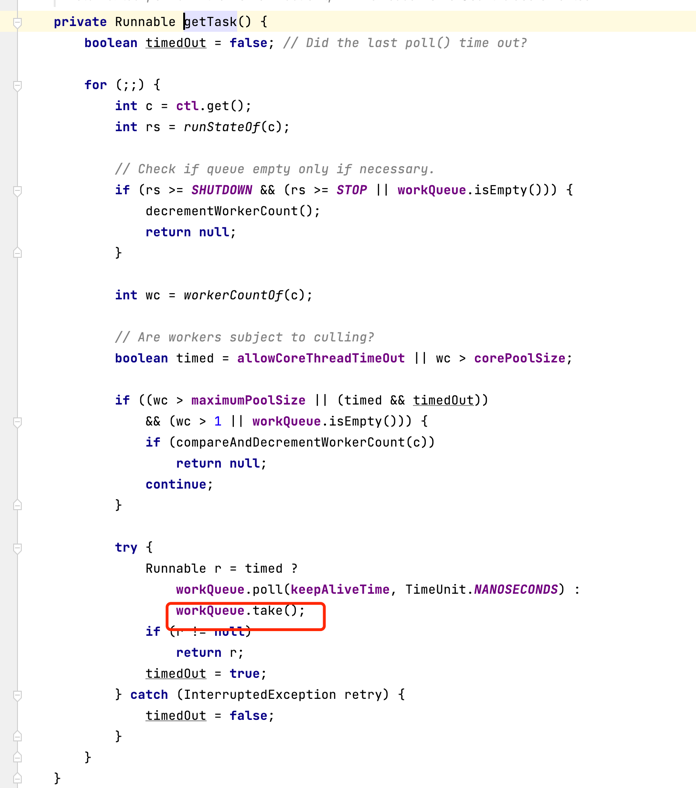











评论